Non-Profit Spotlight: Lomakatsi Restoration Project
By Jennifer Dowdell
Ecological restoration has been characterized not only as a practice of science, but one of hope, faith, and love; a dialogue between humans and nature (Egan, Hjerpe, and Abrams 2011). In the case of indigenous peoples around the world, there is a rich tradition of natural resources management and restoration rooted in ancient practices.
To that end, in 1995 restoration and ethno-ecologist Dennis Martinez led an effort to organize the Indigenous Peoples Restoration Network working group of the Society of Ecological Restoration. Through this work he coined the term eco-cultural restoration: “The process of recovering as much as is recoverable of the key historic pre-contact ecosystem structure, composition, processes, and function, along with traditional, time-tested, ecologically appropriate and sustainable Indigenous cultural practices that helped shape ecosystems, while simultaneously building-in resilience to future rapid climate disruptions and other environmental changes in order to maintain ecological integrity in a way that ensures the survival of both Indigenous ecosystems and cultures.”
That same year, a nonprofit organization took root in the Pacific Northwest, straddling the political boundaries of southern Oregon and Northern California. Lomakatsi Restoration Project, named for the Hopi term meaning “life in balance,” focuses its work on a balance of restoring ecosystems and sustaining communities. Building a restoration economy in a part of the US where many communities face poverty and disenfranchisement meant transitioning from a resource extraction-based industry to an ecological forestry restoration industry.
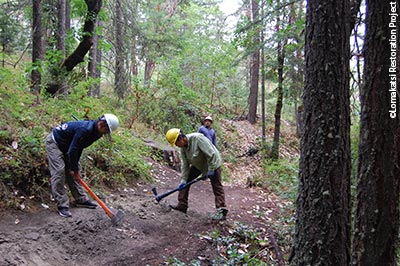
Lomakatsi’s main focus is on restoring resilience to the fire-adapted and dependent ecosystems that dominate this part of the country, mainly the mixed conifer forests and oak woodland habitats. Organized around two main service areas, restoration and education, the organization prioritizes capacity-building in the communities where they work. A special focus over the last 15 years has been their Tribal Ecosystem Restoration Partnership Program. In this program, Traditional Ecological Knowledge (TEK) is seamlessly woven with western science to inform ecological restoration projects and initiatives that assist in building tribal capacity to restore, and benefit from, the resources of their lands.
Belinda Brown, an enrolled member of the Kosealekte Band of the Pit River Tribe, heads up the Tribal Partnership Program for Lomakatsi. As she describes their work, her voice fills with pride and respect.
“To me,” she says, “the beauty of these programs is the live outdoor classroom environment, getting our youth out there to heal the land, which also helps in the healing of our culture, our family, and it provides jobs.”
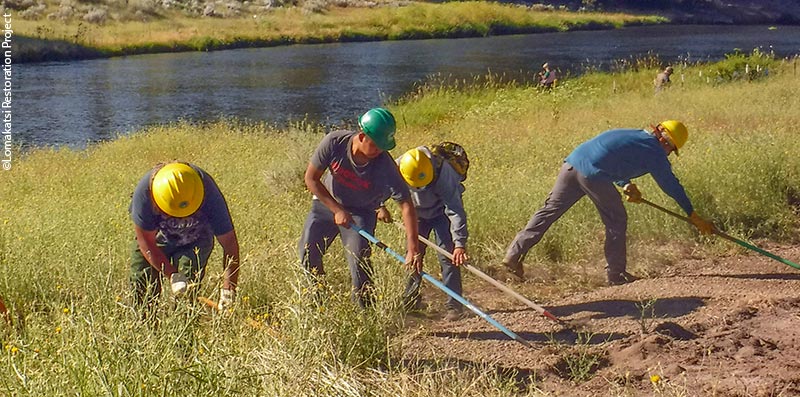
Brown explains that the program places tribal community members back at the center of the management of these lands, as the “first, best stewards of their ancestral lands, utilizing the knowledge of the elders, the language of the place, and the practices that are deeply connected to the history of these landscapes.”
Lomakatsi walks the walk. Not only is the organization focused on tribal partnerships in the projects that it pursues, they also have a staff that is over 60% tribal and Latino, and a board of directors that has 43% tribal and Latino representation.
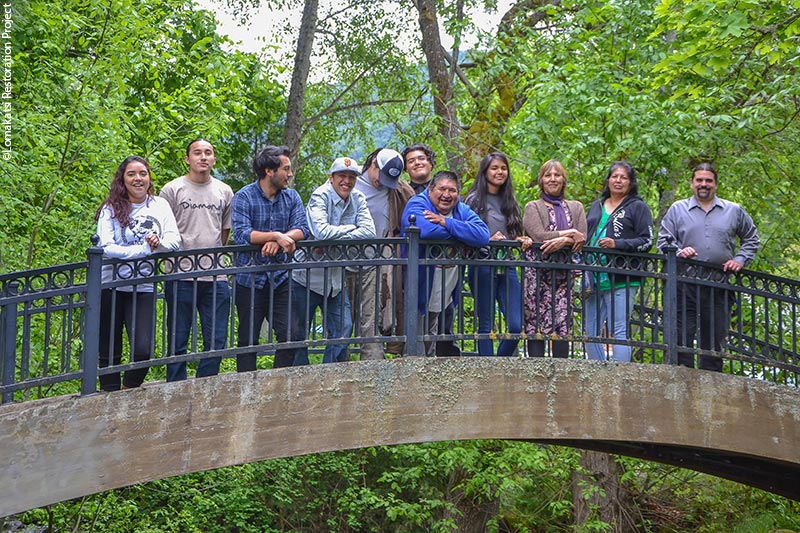
…the beauty of these programs is the live outdoor classroom environment, getting our youth out there to heal the land, which also helps in the healing of our culture, our family, and it provides jobs.
As Marko Bey, Lomakatsi’s Executive Director and Co-founder, explains it, these lands are all considered aboriginal territory, but there are many jurisdictions at play. Lomakatsi has deftly and respectfully navigated the complexities of federally managed public lands (US Forest Service, BLM), tribal trust lands (reservations), and non-industrial private lands to complete six million acres of restoration in eight large-scale projects. With the tribal communities of the Ajumawi/Atsuge Nation (Pit River Tribe), they have worked on acreage that spanned four counties in northeastern California across a range of ecosystems, from sage steppe, to oak woodland, to mixed conifers. In a project to restore redband trout (Oncorhynchus mykiss gairdneri) habitat through the replanting of a riparian corridor with a broad range of native plants that were selected through the guidance of tribal elders, Lomakatsi focused not only on habitat, but edibles, medicinals, and plant materials for traditional basketry and crafts. As Belinda Brown notes, these landscapes are the communities’ hardware stores, grocery stores, and pharmacies, all in one. Lomakatsi has championed peer-to-peer learning between tribal elders and young people. Their youth program restored ancient fish traps along a river, with a focus not only on materials, but on naming and identifying these places. Through these partnerships with tribal communities, the use of language and storytelling is as much a part of the process as the actions taken on the ground.
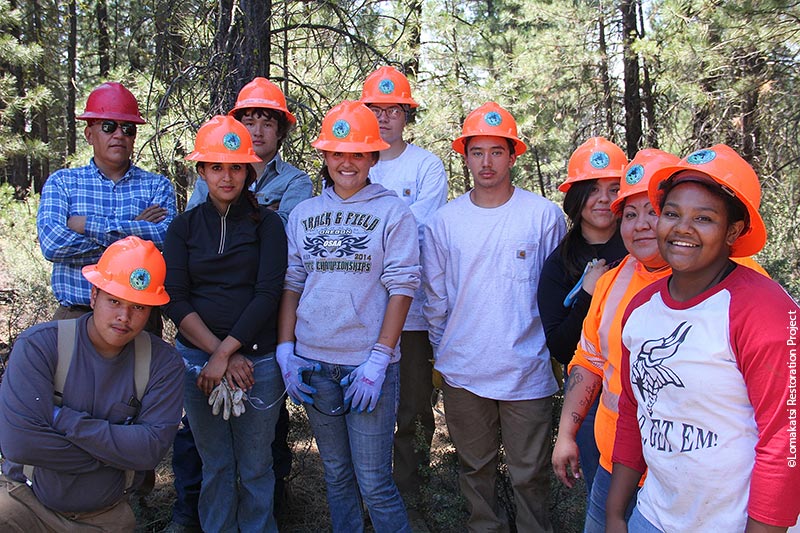
In the case of oak woodland restoration, Lomakatsi helped form the Klamath Siskiyou Oak Network, which is part of an even larger continental Cascade Prairie Oak Partnership. One of the threats to oak habitat is the encroachment of conifers due to the lack of fire. Low intensity fire and selective thinning have been used to preserve these unique and important landscapes. Legacy oak trees (some 350–400 years old) have been maintained over generations by native families who use the acorns as a first food source, used in soup or made into flour. As Bey explains, these forests and woodlands were historically maintained through sophisticated agroforestry practices handed down through ancestral traditions that are now informing current large-scale restoration and management. The multilayered benefits within the system include improved bird habitat and an increasingly diverse and robust understory.
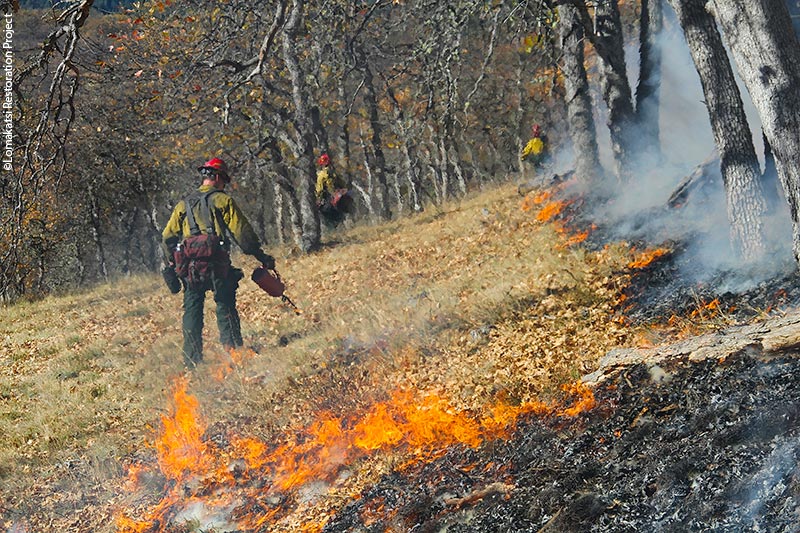
One distinct advantage of working with tribal communities, according to Bey, is that there is a different approach to leveraging resources, especially when tribal governments are partners in the initiatives. Through collaborative efforts, knowledge is shared as well as resources such as staffing and insurance. Lomakatsi aims to continue building capacity and sharing this model more widely, to assist tribal communities as they lead their own efforts in ecological restoration that benefits their land and people.
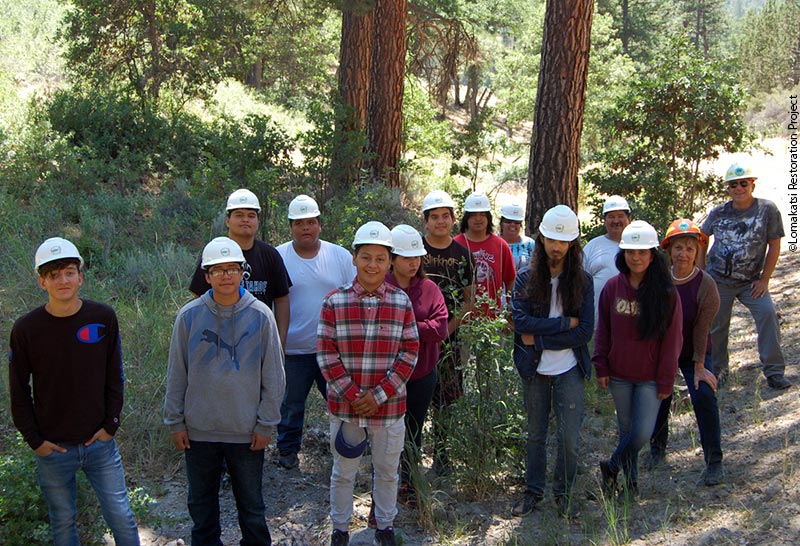
Brown notes that the rituals and ceremonies of indigenous peoples had a huge impact on the way that natural resources were managed. The natural rhythms of the seasons, the earth, the sea, and the stars were used to gauge time in a way that allowed landscapes time to heal or regenerate, following those natural cadences in the landscape. There wasn’t a clock or a 12-month Julian calendar guiding the work, as we experience today.
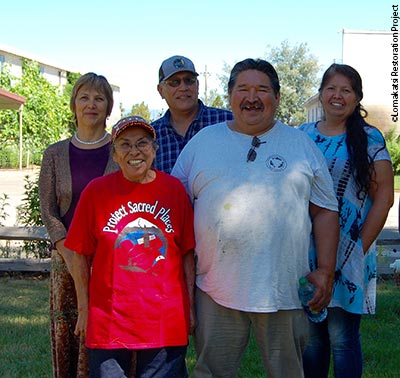
It is that unique sense of time that is at the heart of working with tribal communities, as Bey considers the advice he would share with other designers, scientists, and policy makers who intend to engage with tribal communities in restoration work. He reflects on his own experience as a nontribal member. He notes that it is important to listen to and engage with tribal communities from the beginning of the project and to take the time to understand the nuances of tribal leadership and politics. He explains the importance of slowing down in order to sit, engage, and build trust with the community, particularly the elders. He recalls that one project—a $1.5 million dollar trout restoration—would never have gone forward without the express approval of an 80-year old female elder and ceremonial leader. Bey notes that designers and planners must find ways to employ tribal members; to do research on the tribe’s history and relationships. Brown and Bey are quick to point out that tribes are as unique as ecosystems, with much diversity amongst the communities, and that it is worth the time to engage openly and with transparency. “It might take a little longer,” says Bey, “but in the long term you will have a much stronger project and a better restoration end result involving the first and best stewards of the land.”
Deep gratitude to Belinda Brown and Marko Bey for making the time in their very busy schedules, literally on the phone in the car on the way to a listening session with the US Forest Service, to speak with me about the work that Lomakatsi is doing to build capacity, restore ecosystem health, and strengthen communities.
